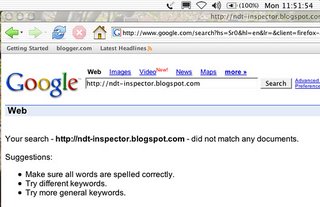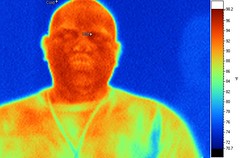TRUE POSITIVE = hit (relevant indication or defect found after a 2nd test)
FALSE POSITIVE = false call (thought it was a hit or defect or an relevant indication, but was actually a miss or non-relevant indication from a 2nd test)
FALSE NEGATIVE = correct accept (thought it was a miss or an non-relevant indiction, but was actually a hit or defect or relevant indication from a 2nd test)
TRUE NEGATIVE = miss (non-relevant indication found after a 2nd test)
Tuesday, September 26, 2006
Tuesday, September 19, 2006
The Blogroll...
I've decided to include a blogroll. These are not an endorsement of this site. But if these sites want to endorse me by all means please.
I find these links interesting for a thorough (not a complete) knowledge of aircraft NDT - that just comes from experience, no matter how smart you are.
Highlights of these sights and/or why I chose them:
AC 65-9A = In chapter ten page 469 begins the NDI section of this FAA advisory circular. Basic methods are covered here. This will download as a PDF.
Airworthiness Assurance NDI Validation Center = a subgroup of Sandia National Labs stationed in Albuquerque, NM. They specialize in NDI research with respect to the aviation sector.
American Society for Nondestructive Testing (ASNT) = The largest American organization for NDT and which I'm a member. This is NDT in general and not sector specific though you can get sector specific. They provide national certification that is usually acknowledged by all industries. This leads me to the next link: ASNT Certification Holders. This site allows you to check for ASNT inspectors in your area.
The Center for Nondestructive Evaluation = A research arm of Iowa State University. They do a lot of aircraft NDT work for the FAA and military.
Chemistry World = A Wolfram Research website that gives the basics of chemistry. I believe every NDT professional should know some chemistry.
The Federal Aviation Administration = The existence of aviation depends on inspections of its airframes and powerplants. I personally met Dr. Al Broz, the Chief NDT Official of the FAA, at an aircraft specific ASNT conference. He is retired U.S. Army and has his doctorate in physics - very smart man and loves to talk.
How an Airplane Works = This site is a basic primer for any NDT professional that has no knowledge of aircraft.
Jets, Inc. = an aircraf company in Texas that does NDT.
Math World = another Wolfram Research arm. I include this because there are some NDT professionals that need a math review.
NDT article in Wiki = this a conglomeration of knowledge for the NDT field and much appreciated.
NDT in Aerospace = this is a subpage of NDT Research Center (link below) that has some basic NDT for the aerospace sector.
NDT Net = an international NDT community.
NDT Org = an NDT community.
NDT Research Center = an NDT site that was funded by the National Science Foundation and maintained by Iowa State.
Olympus NDT = an NDT knowlegde and equipment supplier.
Physics World = physics (along with math) are the basic principles of NDT. I am biased towards Wolfram Research. :)
I find these links interesting for a thorough (not a complete) knowledge of aircraft NDT - that just comes from experience, no matter how smart you are.
Highlights of these sights and/or why I chose them:
AC 65-9A = In chapter ten page 469 begins the NDI section of this FAA advisory circular. Basic methods are covered here. This will download as a PDF.
Airworthiness Assurance NDI Validation Center = a subgroup of Sandia National Labs stationed in Albuquerque, NM. They specialize in NDI research with respect to the aviation sector.
American Society for Nondestructive Testing (ASNT) = The largest American organization for NDT and which I'm a member. This is NDT in general and not sector specific though you can get sector specific. They provide national certification that is usually acknowledged by all industries. This leads me to the next link: ASNT Certification Holders. This site allows you to check for ASNT inspectors in your area.
The Center for Nondestructive Evaluation = A research arm of Iowa State University. They do a lot of aircraft NDT work for the FAA and military.
Chemistry World = A Wolfram Research website that gives the basics of chemistry. I believe every NDT professional should know some chemistry.
The Federal Aviation Administration = The existence of aviation depends on inspections of its airframes and powerplants. I personally met Dr. Al Broz, the Chief NDT Official of the FAA, at an aircraft specific ASNT conference. He is retired U.S. Army and has his doctorate in physics - very smart man and loves to talk.
How an Airplane Works = This site is a basic primer for any NDT professional that has no knowledge of aircraft.
Jets, Inc. = an aircraf company in Texas that does NDT.
Math World = another Wolfram Research arm. I include this because there are some NDT professionals that need a math review.
NDT article in Wiki = this a conglomeration of knowledge for the NDT field and much appreciated.
NDT in Aerospace = this is a subpage of NDT Research Center (link below) that has some basic NDT for the aerospace sector.
NDT Net = an international NDT community.
NDT Org = an NDT community.
NDT Research Center = an NDT site that was funded by the National Science Foundation and maintained by Iowa State.
Olympus NDT = an NDT knowlegde and equipment supplier.
Physics World = physics (along with math) are the basic principles of NDT. I am biased towards Wolfram Research. :)
Labels:
Aerospace,
Documetation,
Experience,
links,
NDE,
NDI,
NDT
Monday, September 18, 2006
Training Musts...
An inspector must have the required documentation for his or her experience from their current AND past employers. These documents should say what requirement the employer chose to fullfill: NAS410, Mil-Std-410, SNT-TC-1A, etc. Usually this includes the hours in the particular method. The employer or inspector supervisor (usually a level 3 or more traditionally, "level III") may include what standards (internal or external) the sample was inspected to, the specific part number and/or serial number. This is basic CYA.
And it makes audits go a lot smoother.
And it makes audits go a lot smoother.
Labels:
Aerospace,
Audit,
Documetation,
Experience,
Hours,
Methods,
NDE,
NDI,
NDT
Greetings...
This blog is about nondestructive testing (NDT). NDT has other names, i.e., nondestructive inspection, and nondestructive evaluation (NDE - more math based). This blog specifically targets the aerospace sector.
NDT is inspecting a sample (in this case, an aircraft part) from a population (the entire airframe/powerplant) without doing harm to that sample with some form of interpretation of the inspection result.
The strictest (and simplest) form of interpretation is pass/fail - similar to a "go no-go" gauge. Other forms of interpretation include specific military or civilian guidelines depending on the customer of the respective industry.
NDT is inspecting a sample (in this case, an aircraft part) from a population (the entire airframe/powerplant) without doing harm to that sample with some form of interpretation of the inspection result.
The strictest (and simplest) form of interpretation is pass/fail - similar to a "go no-go" gauge. Other forms of interpretation include specific military or civilian guidelines depending on the customer of the respective industry.
Labels:
Aerospace,
Interpretation,
NDE,
NDI,
NDT
Subscribe to:
Posts (Atom)

